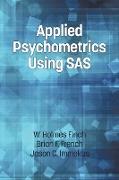Applied Psychometrics Using SAS
BücherAngebote / Angebote:
The book will be designed primarily for graduate students (or advanced undergraduates) who are
learning psychometrics, as well as professionals in the field who need a reference for use in their
practice. We would assume that users have some basic knowledge of using SAS to read data and
conduct basic analyses (e.g., descriptive statistics, frequency distributions). In addition, the
reader should be familiar with basic statistical concepts such as descriptive statistics (e.g., mean,
median, variance, standard deviation), percentiles and the rudiments of hypothesis testing. They
should also have a passing familiarity with issues in psychometrics such as reliability, validity
and test/survey scoring. We will not assume any more than basic familiarity with these issues,
and will devote a portion of each chapter (as well as the entire first chapter) to reviewing many of
these basic ideas for those not familiar with them.
We envision the book as being useful either as a primary text for a course on applied
measurement where SAS is the main platform for instruction, or as a supplement to a more
theoretical text. We also anticipate that readers working in government agencies responsible for
testing and measurement issues at the local, state and national levels, and private testing, survey
and market research companies, as well as faculty members needing a practical resource for psychometric practice will serve as a
market for the book. In short, the readership would include graduate students, faculty members, data analysts and psychometricians
responsible for analysis of survey response data, as well as educational and psychological assessments.
The goal of the book is to provide readers with the tools necessary for assessing the psychometric qualities of educational and
psychological measures as well as surveys and questionnaires. Each chapter will cover an issue pertinent to psychometric and
measurement practice, with an emphasis on application. Topics will be briefly discussed from a theoretical/technical perspective in
order to provide the reader with the background necessary to correctly use and interpret the
statistical analyses that will be presented subsequently. Readers will then be presented with
examples illustrating a particular concept (e.g., reliability). These examples will include a
discussion of the particular analysis, along with the SAS code necessary to conduct them.
The resulting output will then be discussed in detail, focusing on the interpretation of the
results. Finally, examples of how these results might be written up will also be included in the
text. It is hoped that this mixture of theory with examples of actual practice will serve the
reader both as a pedagogical tool and as a reference work.
Folgt in ca. 10 Arbeitstagen
